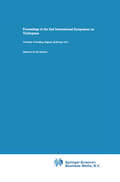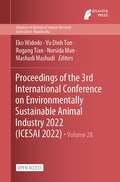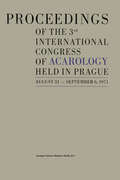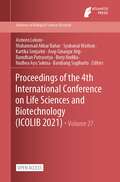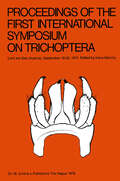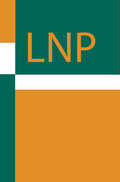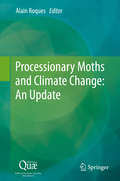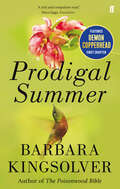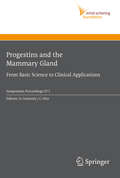- Table View
- List View
Proceedings of the 2nd International Symposium on Trichoptera: University of Reading, England, 25–29 July 1977
by M. I. CrichtonThe 2nd International Symposium on Trichoptera was held at the University of Reading, England, 25-29 July 1977. It attracted 68 participants from 22 countries, which was a gratifying response to the circulation of about 250 workers on caddis flies. It was H. MALICKY who appreciated the need for a specialized meeting of this kind and organized the 1st International Symposium on Trichoptera, which was held at Lunz am See, Austria, 16-20 September 1974. This volume of Proceedings includes 38 papers; all except one were presented and discussed in the sessions listed in the programme. The papers were given in a lecture theatre of the Palmer Building, and demonstrations were laid out in a laboratory of the Department of Zoology where members met for their mprning and afternoon breaks. Members were accommodated in St Patrick's Hall, one of the University Halls of Residence. They were the guests of the University at an informal reception on 25 July. On the afternoon of 27 July an excursion was made to the River Lambourn at Bagnor near NeWbUry. This chalk stream has been the subject of an ecological study by a team from the Department of Zoology since 1970. The excursion was also an opportunity to see something of the local caddis fauna, and to do some collecting. The final session on 29 July, under the chairmanship of G. B. WIGGINS, was followed by a discussion on future plans.
Proceedings of the 3rd International Conference on Environmentally Sustainable Animal Industry 2022 (Advances in Biological Sciences Research #28)
by Eko Widodo Vu Dinh Ton Rugang Tian Norsida Man Mashudi MashudiThis is an open access book.The 3rd ICESAI aims to discuss issues related to the development of an eco-friendly and sustainable livestock industry using smart farming which is related to scientific research and how it is applied. The 3rd ICESAI offers opportunities for the for researchers and the livestock industry from all over the world to share experiences, learn and expand networking on several matters relating to the development of a sustainable and environmentally friendly livestock industry, especially with the implementation of smart farming.
Proceedings of the 3rd International Congress of Acarology
by M. Daniel B. RosickýHeld in Prague, August 31-September 6, 1971
Proceedings of the 4th International Conference on Life Sciences and Biotechnology (Advances in Biological Sciences Research #27)
by Bambang SugihartoThis is an open access book.We are pleased to invite you to participate in the 4th International Confrerence on Life Sciences and Biotechnology, “Towards Sustainable Development: Application of Biosciences to Improve Welfare and Quality of Life“. The International Conference which will be held on by The Department of Biology, Faculty of Mathematics and Natural Sciences, University of Jember November 15-16, 2021.The 1st, 2nd, and 3rd ICOLIB had been successfully held in 2015, 2017, and 2019 in University of Jember, respectively. This year’s conference will be held virtually, and present some outstanding speakers coming from Indonesia, Germany, Nederland, The United States of America and South Korea.
Proceedings of the 9th International Symposium on Insect-Plant Relationships (Series Entomologica #53)
by Erich Städler Martine Rowell-Rahier Robert BaurThe 9th International Symposium on Insect-Plant Relationships (SIP-9) was once more, following the tradition established in 1958, a forum for investigators in both basic and applied entomology interested in the important and fascinating field of interactions between plants and insects. We were pleased and honoured to organise this symposium, which took place June 24--30, 1995 in Gwatt on the shores of the Lake of Thun in Switzerland. 168 participants from 26 countries from all over the world actively took part in the symposium by contributing 12 key-note lectures and a total of 141 oral presentations and posters. The favourable response and the lively interaction of the participants in all symposium activities is the clearest indication of the success of SIP-9. The organisers appreciated the enthusiasm and the willingness to collaborate shown by all participants. The following volume contains written contributions (72) of only half of all presentations. This is due to the fact that we decided to produce not only an account of the proceedings but also to publish all contributions as a special volume of the journal Entomologia Experimentalis et Applicata. This procedure was last adopted in 1978 for SIP-4, organised by Reginald F. Chapman and Elizabeth A. Bernays, and ensures a wide distribution of the papers within the scientific community and easy access through libraries. Inevitably we had to employ the same review procedure as applicable for the manuscripts regularly submitted to Entomologia.
Proceedings of the First International Symposium on Trichoptera: Lunz am See (Austria), September 16–20, 1974
by H. MalickyIn past years there have been several unsuccessful attempts to arrange a symposium on Trichoptera. Letters from fellow workers suggested that now might be an appropriate time, and that a symposium should be held in Lunz. Today it is clear that large congresses are losing their value because of the difficulty of attending all relevant lectures and of finding colleagues. In consequence, small symposia for specialist groups are becoming increasingly important. As I felt that the success of such a symposium must depend on the suggestions from its potential members, I sent out in April 1973, together with a first circular, a questionnaire, asking for opinions on time and length of the symposium, numbers of participants, types of communication, interests within Trichopterology, and lan guages which should be used. The majority of answers suggested the following: The number of participants should be between 20 and 50, and the duration, excluding excursions, should be three to five days; main interests were in ecology and systematics, but there were also interests in physiology, behaviour, zoogeography, morphology, cytotaxonomy and evolution. There was a clear preference for local excursions. Languages should be English, French and German, with a preference for English. The symposium should consist of both formal papers and informal progress reports, with adequate time for discussion. The arrangements have therefore been based on these results.
Proceedings of the Third International Symposium on Trichoptera: Perugia July 28–August 2, 1980 (Series Entomologica #20)
by G. P. MorettiG.P. MORETTI The Triennial Symposium of Trichoptera would seem to have become a regular event on the calendar. Initiated by Prof. Malicky at Lunz in Austria in 1974, they continued at Reading in England in 1977 (Convenor: Dr M.I. Crichton), the last, this year, took place in Perugia, Italy (Convenor: Prof. G.P. Moretti) and the next will be hosted by Dr J.C. Morse in Clemson, U.S.A. in 1983. The most outstanding points of the 3rd International Symposium on Trichoptera held at Perugia from July 28 to August 2, 1980 were I) the high number of participants; 2) the extent, scientific interest and coverage of the papers presented and 3) the warmth and immediate contact which drew everyone together from the first moment. Twenty-one nations (Australia, Austria, Belgium, Bulgaria, Canada, Czechoslavakia, Denmark, France, Germany-F.G.R., Germany-G.D.R., Hungary, Iceland, Italy, Mexico, Netherlands, Poland, Spain, Sweden, Switzerland, United Kingdom, United States) were represented by a total of 63 trichopterologists who presented 54 papers and 8 posters during in 8 sessions chaired by M.I. Crichton, H. Malicky, A. Nielsen, O. Flint, L.
The Process of Animal Domestication
by Marcelo Sánchez-VillagraThe first modern scholarly synthesis of animal domesticationAcross the globe and at different times in the past millennia, the evolutionary history of domesticated animals has been greatly affected by the myriad, complex, and diverse interactions humans have had with the animals closest to them. The Process of Animal Domestication presents a broad synthesis of this subject, from the rich biology behind the initial stages of domestication to how the creation of breeds reflects cultural and societal transformations that have impacted the biosphere.Marcelo Sánchez-Villagra draws from a wide range of fields, including evolutionary biology, zooarchaeology, ethnology, genetics, developmental biology, and evolutionary morphology to provide a fresh perspective to this classic topic. Relying on various conceptual and technical tools, he examines the natural history of phenotypes and their developmental origins. He presents case studies involving mammals, birds, fish, and insect species, and he highlights the importance of domestication for the comprehension of evolution, anatomy, ontogeny, and dozens of fundamental biological processes.Bringing together the most current developments, The Process of Animal Domestication will interest a wide range of readers, from evolutionary biologists, developmental biologists, and geneticists to anthropologists and archaeologists.
The Process of Animal Domestication
by Marcelo Sánchez-VillagraThe first modern scholarly synthesis of animal domesticationAcross the globe and at different times in the past millennia, the evolutionary history of domesticated animals has been greatly affected by the myriad, complex, and diverse interactions humans have had with the animals closest to them. The Process of Animal Domestication presents a broad synthesis of this subject, from the rich biology behind the initial stages of domestication to how the creation of breeds reflects cultural and societal transformations that have impacted the biosphere.Marcelo Sánchez-Villagra draws from a wide range of fields, including evolutionary biology, zooarchaeology, ethnology, genetics, developmental biology, and evolutionary morphology to provide a fresh perspective to this classic topic. Relying on various conceptual and technical tools, he examines the natural history of phenotypes and their developmental origins. He presents case studies involving mammals, birds, fish, and insect species, and he highlights the importance of domestication for the comprehension of evolution, anatomy, ontogeny, and dozens of fundamental biological processes.Bringing together the most current developments, The Process of Animal Domestication will interest a wide range of readers, from evolutionary biologists, developmental biologists, and geneticists to anthropologists and archaeologists.
Processes with Long-Range Correlations: Theory and Applications (Lecture Notes in Physics #621)
by Govindan Rangarajan Mingzhou DingProcesses with long range correlations occur in a wide variety of fields ranging from physics and biology to economics and finance. This book, suitable for both graduate students and specialists, brings the reader up to date on this rapidly developing field. A distinguished group of experts have been brought together to provide a comprehensive and well-balanced account of basic notions and recent developments. The book is divided into two parts. The first part deals with theoretical developments in the area. The second part comprises chapters dealing primarily with three major areas of application: anomalous diffusion, economics and finance, and biology (especially neuroscience).
Processing of Environmental Information in Vertebrates (Proceedings in Life Sciences)
by S. Binkley C. L. Brown P. Deviche R. S. Donham J. A. Elliott B. D. Goldman R. L. Goodman C. A. Marler F. L. Moore M. C. Moore S. M. Reppert M. H. Stetson H. Underwood M. Watson-Whitmyre D. R. Weaver F. E. Wilson J. C. WingfieldIn just one concise and lucidly written volume a multitude of topics is covered introducing the results of extensive research on the processing of environmental information in vertebrates. Practical examples are provided to illustrate points made in the text. Many factors, both from the external environment and from within the animals own cells or tissue makeup can directly serve as a pressure to elicit physiological and/or behavioral responses in the organisms studied. Light intensity, photoperiod, circadian rhythms, seasonal variation and daylenght, just to name a few, are among the environmental factors that are correlated in these studies to behavioral or hormonal changes, organ function, and reproduction. This work will serve as a guidebook and easy reference source for students and research professionals in physiology, endocrinology, comparative zoology, and veterinary science.
Processionary Moths and Climate Change: An Update
by Alain RoquesBecause of its peculiar biology, its negative impacts on forestry, and its urticating larvae affecting human and animal health, pine processionary moth has largely been studied in many European countries during the last century. However, knowledge remained scattered and no synthesis has ever been published. Since the IPCC retained the moth as one of the two insect indicators of climate change because of its expansion with warming up, filling this gap became increasingly important. Led by INRA, this book associates 101 authors from 22 countries of Europe, Minor Asia and North Africa, combining all the concerned research fields (entomology, ecology, genetics, mathematical modelling, medical and veterinary science, pest management) in a multidisciplinary approach to understand and model the processes underlying past, present and future moth expansion and to propose adapted management methods. Besides, the major biological patterns of the related processionary species are also detailed.
Prodigal Summer: A Novel
by Barbara KingsolverIt is summer in the Appalachian mountains and love, desire and attraction are in the air. From her outpost in an isolated mountain cabin, Deanna Wolfe, a reclusive wildlife biologist, watches a den of coyotes. She is caught off guard by a young hunter who invades her most private spaces and interrupts her solitary life. On a farm several miles down the mountain, Lusa Maluf Landowski, a bookish city girl turned farmer's wife, finds herself marooned in a strange place where she must declare or lose her attachment to the land that has become her own. And a few more miles down the road, a pair of elderly feuding neighbours tend their respective farms and wrangle about God, pesticides, and the possibilities of a future neither of them expected. Over the course of one humid summer, these characters find their connections of love to one another and to the surrounding nature with which they share a place. With its strong balance of narrative and drama, Prodigal Summer is stands alongside The Poisonwood Bible and The Lacuna as one of Barbara Kingsolver's finest works.
Productive Safety Management
by Tania MolUnlike most books on this subject, Productive Safety Management, described in this book, integrates occupational health and safety, human resource management, environmental management, and engineering to provide a whole-business approach to effective safety management.The book helps companies to reduce and manage risk by providing, analysing and improving systems in place within the company. It also looks at how external factors can affect company decision making and provides a tool to make sure that a health and safety management system is strategically aligned, appropriately resourced, and that it maximises employee commitment. Chapters on human resource management explore cultural issues and explain how to gain commitment to company objectives.The book has been written for managers and supervisors working in hazardous industries, OHS practitioners, undergraduate and postgraduate students.
Productive Safety Management: A Strategic, Multi-disciplinary Management System For Hazardous Industries That Ties Safety And Production Together
by Tania MolUnlike most books on this subject, Productive Safety Management, described in this book, integrates occupational health and safety, human resource management, environmental management, and engineering to provide a whole-business approach to effective safety management.The book helps companies to reduce and manage risk by providing, analysing and improving systems in place within the company. It also looks at how external factors can affect company decision making and provides a tool to make sure that a health and safety management system is strategically aligned, appropriately resourced, and that it maximises employee commitment. Chapters on human resource management explore cultural issues and explain how to gain commitment to company objectives.The book has been written for managers and supervisors working in hazardous industries, OHS practitioners, undergraduate and postgraduate students.
Professional Gundog Training: The Trade Secrets
by Joe IrvingA gundog training book, which reveals the techniques used by the professional trainers and enables the individual gundog owner to utilise them for their own training programme. Set out in an A-Z format, it covers the various aspects of gundog training as well as giving advice on field trials, breeding and general care and management of gundogs.
Professionalism and Reflection in Veterinary Nursing
by Sue Badger Andrea JefferyProfessionalism and Reflection in Veterinary Nursing Professionalism and Reflection in Veterinary Nursing offers insight into the role of the veterinary nurse in the 21st century. It provides useful information that facilitates a deeper understanding of the underlying theory that supports clinical nursing practice. Exploring concepts that underpin the delivery of professional veterinary nursing, the book covers core issues, themes and principles that explain what it means to be a veterinary nurse. The role of the registered veterinary nurse The registered veterinary nurse’s responsibility to the patient Evidence-based veterinary nursing Veterinary nurse trainer and educator resources A timely publication due to the increased recognition and expectations of the role of the veterinary nursing profession, Professionalism and Reflection in Veterinary Nursing is ideal for veterinary student nurses and qualified veterinary nurses, enabling them to contribute to the development of the professional identity.
Professionalism and Reflection in Veterinary Nursing
by Andrea Jeffery Susan F. BadgerProfessionalism and Reflection in Veterinary Nursing Professionalism and Reflection in Veterinary Nursing offers insight into the role of the veterinary nurse in the 21st century. It provides useful information that facilitates a deeper understanding of the underlying theory that supports clinical nursing practice. Exploring concepts that underpin the delivery of professional veterinary nursing, the book covers core issues, themes and principles that explain what it means to be a veterinary nurse. The role of the registered veterinary nurse The registered veterinary nurse’s responsibility to the patient Evidence-based veterinary nursing Veterinary nurse trainer and educator resources A timely publication due to the increased recognition and expectations of the role of the veterinary nursing profession, Professionalism and Reflection in Veterinary Nursing is ideal for veterinary student nurses and qualified veterinary nurses, enabling them to contribute to the development of the professional identity.
Progestins and the Mammary Gland: From Basic Science to Clinical Applications (Ernst Schering Foundation Symposium Proceedings #2007/1)
by O. Conneely C. OttoProgestins play a key role in reproductive endocrinology and as pharmaceutical drugs for contraception and in combined hormone therapy. To further our understanding of progestin action in the mammary gland, an international symposium, attended by leading researchers from academia and industry, was held in Berlin, 21–23 March 2007. Genetic mouse models helped to elucidate the role of progestins, both in normal breast development and in disease. Mechanistic molecular studies inspired the design of new progestins with improved tissue selectivity. In addition, the clinical impact of progesterone receptor agonists and antagonists for the prevention and treatment of breast cancer was discussed.
Programmed Cell Death
by Yun-Bo Shi Yufang Shi Yonghua Xu David W. ScottThis volume contains papers that were presented and discussed at The 1996 Interna tional Symposium on Programmed Cell Death, which was held in the Shanghai Science Center of the Chinese Academy of Sciences on September 8-12, 1996. Apoptosis has attracted great attention in the past several years. This is reflected in part by the exponential increase in the number of papers published on the subject. While several major scientific conferences have been held in recent years, this meeting repre sents the first major international scientific meeting on programmed cell death held in Asia, where fast economic growth promises a bright future for both basic and applied re search in biomedical sciences. We organized the meeting with the belief that such a gath ering would foster a closer interaction between scientists from the West and those in Asia. Research on programmed cell death has expanded so extensively that no one meet ing can cover all the important subjects related to apoptosis. The Shanghai meeting fo cused on several key areas ranging from well-established ones, such as cell death in the immune system, to emerging ones, such as the role ofECM in regUlating cell fate. Specifi cally, the subjects presented and discussed included programmed cell death during devel opment, the regulation and biochemical mechanisms of lymphocyte apoptosis, the involvement of extracellular matrix and its remodeling in programmed cell death, genes that cause or prevent cell death, and the application of apoptosis toward cancer therapy.
Progress and Prospects in Evolutionary Biology: The Drosophila Model
by Jeffrey R. PowellThis book focuses on drosophila as an especially useful model organism for exploring questions of evolutionary biology in the full range of evolutionary studies: population genetics, ecology, ecological genetics, speciation, phylogenetics, genome evolution, molecular evolution, and development. The author presents an integrated view of evolutionary biology as elucidated in this single organism. Special effort is made to point out holes in our knowledge and areas particularly ripe for new investigation.
Progress in Botany: Structural Botany Physiology Genetics Taxonomy Geobotany/Fortschritte der Botanik Struktur Physiologie Genetik Systematik Geobotanik (Progress in Botany #50)
by H.-Dietmar Behnke Karl Esser Klaus Kubitzki Michael Runge Hubert ZieglerThe 50th volume of Progress in Botany appears in new guise. In cooperation with Springer-Verlag we have changed from the less attractive typewriter composition to the direct reproduction of a manuscript which was writ ten by means of a text editing system and produced by a laser printer. We, the editors, should like to take the appearance of Volume 50 as the occasion for a few short remarks. Our younger readers are perhaps not aware that our Book Series was founded in 1931 by Fritz von Wettstein, based on the following thoughts and considerations, aptly formulated by him in the Preface to the first volume. "One of the greatest dangers threatening progress in the science of botany is the absolutely unbelievable growth in volume of the literature. The quality of journals, books and individual works that are daily sent to us makes it impossible for anyone person to maintain a general view of the progress made in botany in all the specialized fields, let alone to find time for results from associated su bjects. For varying reasons, every botanist must find this state of matters insupportable. Let us endeavor, in the general interest, to retain a wide background of knowledge, and not become limited specialists. The vitally necessary connections between the specialized fields can only flourish, or even exist, if the general view of botany as a whole can be maintained.
